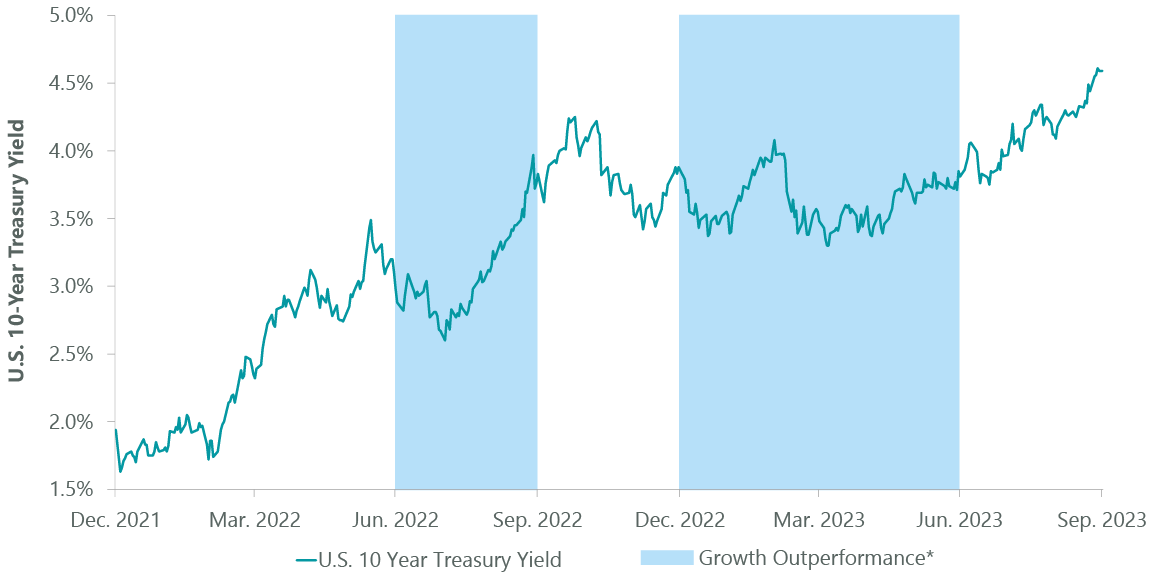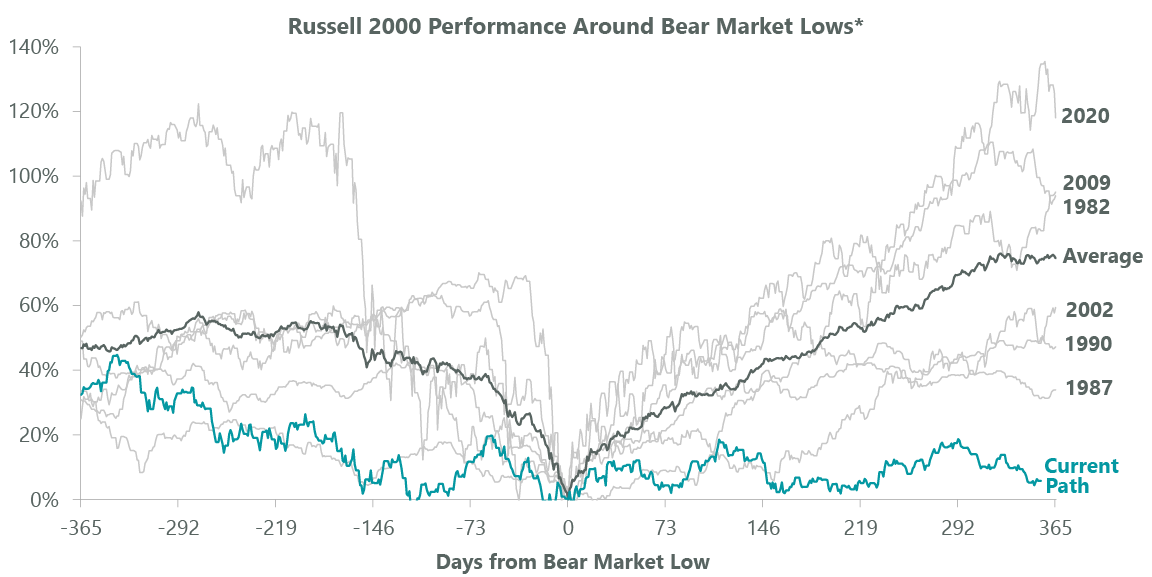By Aram Green
Leaning into Growth Down the Cap Spectrum
Market Overview
Equities were pressured in the third quarter by rising bond yields and a hawkish turn by the Federal Reserve. The S&P 500 Index (SP500, SPX) fell 3.27%, the benchmark Russell 3000 Index declined by 3.25% while the Russell 2000 Index (RTY) dropped 5.13% as the Fed indicated that generationally high interest rates could remain elevated well into 2024.
The 10-year Treasury yield climbed 74 bps during the quarter, reaching its highest level in 16 years (Exhibit 1). Surging yields, which have the greatest impact on longer-duration assets including growth stocks whose earnings are valued well into the future, have resulted from resilient economic data and a rebound in inflation that caused the Fed to push out any hopes of a rate cut in the near term. While the central bank may be nearing or at the end of its tightening cycle, the lagging impacts of 525 bps of interest rate hikes in the last 18 months will be felt on corporate and consumer balance sheets well into the future.
Exhibit 1: Rising Yields Again Pressuring Growth Stocks

| *Growth Outperformance indicates quarterly periods where the Russell 1000 Growth Index outperformed the Russell 1000 Value Index. Data as of Sept. 30, 2023. Source: FactSet. |
Longer-duration growth stocks trailed value, most notably among smaller cap companies. The Russell 3000 Growth Index (-3.35%) underperformed the Russell 3000 Value Index (-3.15%) while the Russell 2500 Growth Index, a proxy for small and mid cap growth stocks, declined 6.84%, underperforming the Russell 2500 Value Index (-3.66%) by 318 bps.
Growth remains well ahead of value year to date, mostly a function of outperformance among the “Magnificent Seven,” a collection of mega cap growth companies including Alphabet (GOOG,GOOGL), Amazon (AMZN), Apple (AAPL), META Platforms, Microsoft (MSFT), Nvidia (NVDA) and Tesla (TSLA), which currently dominate market-cap-weighted benchmarks. The ClearBridge Select Strategy has limited exposure to these stocks – we are overweight Nvidia versus the benchmark and also own Apple – which supported relative results in the third quarter.
The Strategy held up better than SMID and small cap growth indexes during the quarter but underperformed the broad Russell 3000 Index benchmark as our more defensive and larger cap positions did not protect as well as we would have expected.
Results were primarily impacted by weakness among two health care holdings, Insulet (PODD) and Surgery Partners (SGRY). Positive clinical studies for GLP-1 therapeutics showed substantial health benefits to diabetic and obese patients, boosting stock prices of pharmaceutical companies tied to the manufacturing of these drugs. The potential for improved patient outcomes raised the risk of lower utilization for Insulet, a maker of insulin patch pumps, and Surgery Partners, whose outpatient surgery centers conduct weight loss and many other types of outpatient procedures. Though the GLP-1 threat is weighing on the valuation multiple of Insulet, any negative effects would likely not meaningfully affect the business for many years, especially given how large and underpenetrated the Type 2 diabetes market is for the company currently. Additionally, this could require significant improvements in cost, availability, and adherence for GLP-1s. Furthermore, we are encouraged that the majority of Insulet’s business today is still from Type 1 diabetes, where fundamentals remain strong and the company is gaining share.
Our information technology (IT) exposure also detracted from results as higher growth, higher multiple disruptors came under pressure from rising rates and a more cautious demand environment. Information security software platform Fortinet dropped sharply after its second quarter revenue and billings numbers missed forecasts and the company reduced third quarter and full-year guidance as backlog trends normalize post last year’s supply chain issues.
Solar energy technology companies SolarEdge (SEDG) and Shoals (SHLS), meanwhile, saw headwinds from destocking in the U.S. and Europe. U.S. demand could slow further due to new net metering rules that reduce the value to consumers from sending excess residential solar energy back to the grid. SolarEdge, which makes inverters for solar systems as well as residential and commercial battery systems, is also facing rising battery competition in the U.S. from Tesla.
Performance was boosted in the quarter by the Strategy’s more economically-sensitive holdings among steady compounders and evolving opportunities. Vertiv (VRT), a leader in power and thermal management for data centers, saw its shares rerate on strong data center demand and enthusiasm for AI-related technology. The company’s new management has kept cost inflation under control while maintaining strong orders and backlog, resulting in improved margins and its best free cash flow generation to date. Exploration and production company Pioneer Natural Resources (PXD), which received a takeover offer from Exxon Mobil (XOM) in early October, and oilfield equipment and services provider Baker Hughes (BKR), meanwhile, benefited from a $20 rise in crude oil prices as well as disciplined execution.
Portfolio Positioning
Taking advantage of rate-related price dislocations, the Strategy added six new common stock positions during the quarter and participated in two IPOs, one being Klaviyo (KVYO), an existing private holding for the strategy. Klaviyo is a founder-led software and database platform that provides marketing automation solutions primarily to smaller e-commerce customers. Leveraging a tight integration with e-commerce enablement provider Shopify (SHOP) and a disruptive technology architecture, Klaviyo has experienced rapid growth in a sizable core market, with opportunities to add additional products and customer groups, including the fitness/wellness market, and to expand internationally. Throughout its history, the company has managed to balance a robust growth rate with disciplined investment and has a path to meaningful long-term profitability.
We also participated in the IPO of Oddity Tech (ODD), a direct to consumer cosmetics business that is growing rapidly and already profitable. Oddity is marketing two brands today and investing in new brands including a biotechnology treatment for hair loss. The company uses AI and related technologies to connect with consumers, such as tools that examine a customer’s complexion to customize cosmetics. The company also integrates customer feedback into its sales process.
Our largest new addition was Waste Connections (WCN), a durable compounder in the industrials sector. WCN is a Canada-based waste management provider that continues to grow through accretive acquisitions. The company could see better-than-expected margin expansion over the next several years, driven by a combination of recovering recycled commodities and renewables credits, greater than normal pricing power due to lagged inflation-index realization and improved labor costs and utilization driven by lower labor turnover.
Within health care, we added two new positions that further balance the portfolio. ICON (ICLR), a contract research organization (CRO), is another durable compounder seeing multiple expansion as a spending slump among its biopharmaceutical customers has not been as severe as feared. Biotech funding trends are stabilizing but could take a few quarters for this to show up in order/sales numbers. We view ICON as the best-positioned clinical CRO, led by a solid management team capable of compounding earnings in the low double digits over the next several years driven by steady revenue, margin expansion and financial leverage. We see ICON as an upgrade to Syneos Health (SYNH), a rival CRO we exited during the quarter ahead of it being taken private. New addition Argenx (ARGX) is a Dutch biotechnology firm we consider a disruptor due to its unique treatments for rare diseases. The company demonstrated a successful launch during the quarter for its myasthenia gravis drug to treat an autoimmune disorder of the muscular system. Argenx is targeting the same molecule to treat other rare diseases, with key readouts by year end or early next year.
Outlook
Despite the challenging conditions created by higher rates and limited liquidity, we continue to believe the market will value growth in a slowing economic backdrop. The Strategy continues to lean into growth, as evidenced by our higher forward earnings growth rate versus the benchmark, although we have purposely avoided overweighting smaller cap stocks this year due to our expectation of a volatile macro backdrop.
Exhibit 2: Small Caps Struggling

| *Bear Market Low is day 0, based on S&P 500. Source: S&P, Russell, FactSet. |
At this point, however, we are becoming more constructive on small caps as the relative performance gap between the Russell 2000 and the S&P 500 has reached significant proportions. We remain patient and are putting in the work among smaller companies to ensure potential additions meet our quality criteria and complement the overall portfolio. One area of particular interest is the alternative energy space, which has been hit hard by rising rates and slowing demand as net metering incentives for residential solar have been lowered.
The Strategy has been involved in a fair number of acquisitions in recent quarters, which we view as a healthy sign that the qualities we seek in our portfolio holdings are attractive to strategic acquirers and other companies seeking new sources of growth. The new issue market is also coming back to life, albeit sluggishly, after an extended lull due to market volatility and a sharp rise in interest rates over the last 18 months.
Since the IPO market reopened, healthy companies that raised money have earned higher valuations while those in need of financing have not. While many companies are seeking to get listed now that the window is open, we remain selective in our participation, tapping our private markets experience and fundamental research to identify businesses that are already profitable or with a clear sightline to positive earnings.
Portfolio Highlights
The ClearBridge Select Strategy underperformed its Russell 3000 Index benchmark during the third quarter. On an absolute basis, the Strategy posted losses gains across eight of the 10 sectors in which it was invested (out of 11 sectors total). The lone contributors were the energy and financials sectors, while the IT and health care sectors were the main detractors.
Relative to the benchmark, overall stock selection and sector allocation detracted from performance. In particular, stock selection in the health care sector was the primary drag on results. Selection in the communication services, IT, consumer discretionary, materials and real estate sectors and underweights to communication services and financials also weighed on returns. Conversely, stock selection in the financials and consumer staples sectors contributed to performance.
On an individual stock basis, the leading contributors were positions in Vertiv, HealthEquity (HQY), Pioneer Natural Resources, New Relic (NEWR) and Casey’s General Stores (CASY). The primary detractors were Insulet, Surgery Partners, Fortinet (FTNT), Apple and Shoals Technologies.
In addition to the transactions mentioned above, we started new positions in Morgan Stanley (MS) in the financials sector while in the IT sector we added Autodesk (ADSK) and Palo Alto Networks (PANW) and increased our holding in privately-held Databricks. We also exited positions in XPO in the industrials sector and Alnylam Pharmaceuticals (ALNY) in the health care sector.
Aram Green, Managing Director, Portfolio Manager
|
Past performance is no guarantee of future results. Copyright © 2023 ClearBridge Investments. All opinions and data included in this commentary are as of the publication date and are subject to change. The opinions and views expressed herein are of the author and may differ from other portfolio managers or the firm as a whole, and are not intended to be a forecast of future events, a guarantee of future results or investment advice. This information should not be used as the sole basis to make any investment decision. The statistics have been obtained from sources believed to be reliable, but the accuracy and completeness of this information cannot be guaranteed. Neither ClearBridge Investments, LLC nor its information providers are responsible for any damages or losses arising from any use of this information. Performance source: Internal. Benchmark source: Standard & Poor’s. Performance source: Internal. Benchmark source: Russell Investments. Frank Russell Company (“Russell”) is the source and owner of the trademarks, service marks and copyrights related to the Russell Indexes. Russell® is a trademark of Frank Russell Company. Neither Russell nor its licensors accept any liability for any errors or omissions in the Russell Indexes and/or Russell ratings or underlying data and no party may rely on any Russell Indexes and/or Russell ratings and/or underlying data contained in this communication. No further distribution of Russell Data is permitted without Russell’s express written consent. Russell does not promote, sponsor or endorse the content of this communication. |
Original Post
Editor’s Note: The summary bullets for this article were chosen by Seeking Alpha editors.
Editor’s Note: This article discusses one or more securities that do not trade on a major U.S. exchange. Please be aware of the risks associated with these stocks.
Read the full article here



